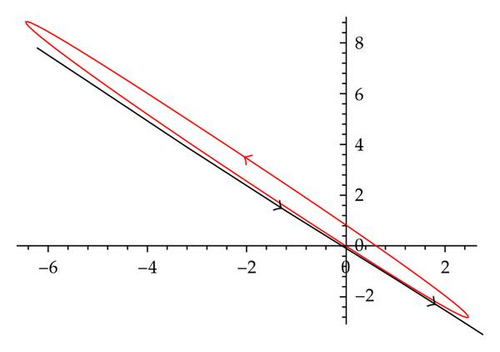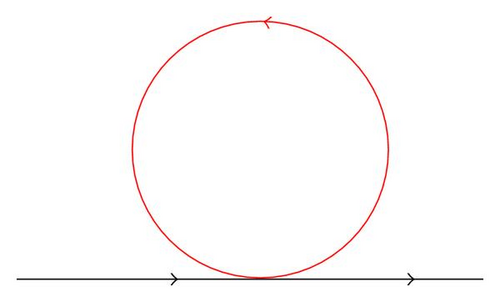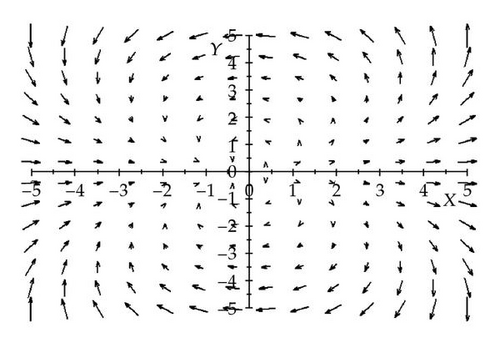On Algebraic Approach in Quadratic Systems
Abstract
When considering friction or resistance, many physical processes are mathematically simulated by quadratic systems of ODEs or discrete quadratic dynamical systems. Probably the most important problem when such systems are applied in engineering is the stability of critical points and (non)chaotic dynamics. In this paper we consider homogeneous quadratic systems via the so-called Markus approach. We use the one-to-one correspondence between homogeneous quadratic dynamical systems and algebra which was originally introduced by Markus in (1960). We resume some connections between the dynamics of the quadratic systems and (algebraic) properties of the corresponding algebras. We consider some general connections and the influence of power-associativity in the corresponding quadratic system.
1. Introduction
The stability of hyperbolic critical points in nonlinear systems of ODEs is well-known. It is described by the stable manifold theorem and Hartman′s theorem. The critical (or equilibrium or stationary or fixed) point of or is defined to be the solution of the following algebraic (system of) equation(s), or , respectively. For the systems of ODEs, , the critical point is said to be hyperbolic if no eigenvalue of the corresponding Jacobian matrix, , of the (nonlinear vector) function f has it is eigenvalue equal to zero (i.e., Re(λi) ≠ 0). In case of discrete system, , the critical point is said to be hyperbolic if no eigenvalue of the Jacobian matrix has it is eigenvalue equal to 1 (i.e., |λi| ≠ 1). Roughly speaking, if for a continuous system Re(λi) < 0 for every λi, the corresponding critical point is stable (it is unstable, if Re(λi) > 0 for some λi). Similar, if for discrete systems |λi| < 1 for every λi, the corresponding critical point is stable (it is unstable, if |λi| > 1 for some λi). Note that just one eigenvalue of the corresponding linear approximation of or for which Re(λi) = 0 or |λi| = 1, respectively, implies that the stability must be investigated separately in each particular case (because of the significance of the higher order terms). Such articles where for the non-hyperbolic critical points the classes of stable and unstable systems are considered are published constantly. (The authors consider the influence of at least quadratic terms added to the linear ones.) The most recent article on quadratic systems might be [1]. For homogeneous quadratic systems the origin is an example of the so-called totally degenerated (i.e., non-hyperbolic) critical point.
In the sequel we consider the existence of some special algebraic elements (i.e., nilpotents of rank 2 and idempotents), as well as the reflection of algebra isomorphisms in the corresponding homogeneous quadratic systems, which represents the basis for the linear equivalence classification of homogeneous quadratic systems. It was already used by the author in order to analyze the stability of the origin in the continuous case in IR2 and in IR3 (the origin is namely a total degenerated critical point for in any dimension n [3]).
The interested reader is invited to consult, for example, [6–10] to obtain some further informations.
Thus, in the standard basis e1 = (1,0) and e2 = (0,1) the multiplication table for the corresponding algebra is as illustrated in Table 1.
| * | e1 | e2 |
| e1 | e1 | e2 |
| e2 | e2 | −e1 |
Applying the substitution (i.e., the algebra isomorphism) e1 → 1, e2 → i one obtains as illustrated in Table 2 which is readily recognized as the algebra of complex numbers.
| * | 1 | i |
| 1 | 1 | i |
| i | i | − 1 |
On the other hand, beginning, for example, with the algebra A = (IR3, *) given with the multiplication table as illustrated in Table 3 the corresponding quadratic form is obtained again by applying .
| * | e1 | e2 | e3 |
| e1 | e1 | e2 | e3 |
| e2 | e2 | −e1 | 0 |
| e3 | e3 | 0 | −e1 |
2. Some Connections between Systems and Their Corresponding Algebras
In order to achieve better understanding let us recall some definitions from the dynamical systems and algebra theory. A subset W⊆A which is closed for algebraic multiplication (i.e., for every pair w1, w2 ∈ W we have w1*w2 ∈ W) is called a subalgebra. For example, if the corresponding vector space is a direct sum of two (vector) subspaces (i.e., V = V1 ⊕ V2) and if A1 = (V1, *) and A2 = (V2, *), then A = A1 ⊕ A2 = (V1 ⊕ V2, *) contains two nontrivial subalgebras A1 and A2. To every one can associate a subalgebra , defined by products , , , , , , , and so on and their linear combinations, which is called the subalgebra generated by the element . A subalgebra I⊆A is called (left and right) ideal of algebra A, if AI⊆I and IA⊆I (i.e., for every i ∈ I and every we have and ). Every algebra A = (V, *) has at lest two ideals, the trivial ideals V and {0}. Furthermore, the set A2 = A*A defined as the subspace of all linear combinations of products in A is obviously an ideal of A.
The map ϕ : A → B is homomorphism from algebra (A, *) into algebra (B, ∘), if and only if, for every pair of vectors from algebra A we have: . If there is a homomorphism from algebra A to algebra B they are called homomorphic. A bijective homomorphism is called an isomorphism and the corresponding algebras are called isomorphic (in this case m = n). By S* and S∘ let us denote the corresponding quadratic (continuous or discrete) systems. The map h : IRn → IRn preserves solutions from system into system if and only if it takes parametrized solutions of the first system into parametrized solutions of the second one (i.e., is a solution of system S∘, whenever is a solution of S*. In discrete systems the solutions, ; k = 0,1, 2, … are called orbits. By preserving of orbits we mean that ; k = 0,1, 2, … is an orbit of system S∘, whenever ; k = 0,1, 2, … is an orbit of system S*.
Element of algebra (A, *) is said to be a nilpotent of rank 2, if and it is said to be an idempotent, if . If for some point the algebraic equation or is fulfilled, it is called critical point of system or , respectively. The solution is a ray solution of if for every time t vector remains on the line .
2.1. Algebraic Isomorphism and Linear Equivalence
The basic correspondence (1.1) between quadratic systems and algebras is the same for as well for . The basic property concerning the linear equivalence between quadratic systems is also very similar as shown in the following two Propositions.
Proposition 2.1. Let ϕ : IRn → IRm be linear. Then ϕ preserves solutions from system ; into system ; if and only if ϕ is a homomorphism from algebra A* = (IRn, *) into algebra A∘ = (IRm, ∘).
Proof. Let ϕ be some linear map which preserves solutions from S* into S∘. And let A* = (IRn, *) and A∘ = (IRm, ∘) be the corresponding algebras. Let be the solution of S* and let be the solution of S∘. Thus and and from one obtains . Since ϕ is linear it is Jacobian is equal to ϕ in every point of the space (i.e., ϕ′ = ϕ). Therefore for every . Substituting and applying commutativity and bilinearity of multiplications ∘ and *, we obtain , for all . Since ϕ is linear by assumption, this yields that ϕ is a homomorphism from A* = (IRn, *) into A∘ = (IRm, ∘).
Conversely, let ϕ be homomorphism from A* = (IRn, *) into A∘ = (IRm, ∘). Thus, for all we have . For we readily obtain: . Using again ϕ′ = ϕ, we obtain
Proposition 2.2. Let ϕ : IRn → IRm be linear. Then ϕ preserves orbits from system ; into system ; if and only if ϕ is a homomorphism from algebra A* = (IRn, *) into algebra A∘ = (IRm, ∘).
The proof is very similar to the proof of Proposition 2.1 and will be omitted here.
The use of Propositions 2.1 and 2.2 is quite similar. In the following Example the use of Proposition 2.1 is considered.
Example 2.3. Systems




The immediate corollary is that systems S* and S∘ are linearly equivalent if and only if their corresponding algebras A* and A∘ are isomorphic.
2.2. Algebraic Structure and Reductions of the System
The above-mentioned corollary and the so-called Kaplan-Yorke theorem is a basement of algebraic treatment of homogeneous quadratic systems using algebraic classification of the commutative algebras. The following algebraic result due by Kaplan and Yorke [12] affects strongly on the dynamics of homogeneous quadratic systems.
Theorem 2.4 (Kaplan-Yorke). Every real finite dimensional algebra A* = (IRm, *) contains at least one nonzero idempotent or a nonzero nilpotent of rank two.
For proof please refer to the original paper [12].
Concerning the existence of a subalgebra, we have the following result.
Proposition 2.5. A homogeneous quadratic system S* has an invariant r-dimensional linear subspace Er if and only if the corresponding algebra has an r-dimensional subalgebra.
Remark 2.6. We present just the proof for discrete case (i.e., when ; . The proof for continuous system ; can be found, for example, in Markus [2].
Proof. Let Er = span (e1, e2, …, er) be an invariant r-dimensional linear subspace of a n-dimensional vector space V, n > r. Then for every the orbit is contained in Er. We will prove that (Er, *) is the r-dimensional subalgebra (i.e., the subspace Er is closed for multiplication *). Setting we have ei*ei ∈ Er for every 1 ≤ i ≤ r. Now we want to prove that ei*ej ∈ Er for all 1 ≤ i, j ≤ r. In order to prove this, let us set and compute using the commutativity rule in algebra
Concerning the existence of a subalgebra and an ideal in the corresponding algebra let us mention the following result, (for proof please refer to [10]).
Proposition 2.7. Let I be an ideal of algebra A* and W a subagebra such that V = I ⊕ W. Then the solution of the initial value problem of the corresponding quadratic system with the initial value problem can be solved by successive solution of
Corollary 2.8. A system with the initial condition splits into two separated subsystems
Proof. Apply I = I1 and W = I2 in the previous result and take into consideration that I1, I2 are both ideals which means that 2w(t)*i = 0 in the second equation of Proposition 2.7. This finishes the proof.
The last two results are further examples where exactly analogous results can be formulated for the discrete case. Note that the reduction and/or splitting of the system is of great importance when exact solutions are needed.
2.3. Special Algebraic Elements and (In)Stability
However, some connections between the system and corresponding algebra (A, *) differs in the continuous and discrete case. For example the correspondence between ray solutions/fixed points and idempotents/nilpotents. Let us first recall the Lyapunov definition of stability.
Definition 2.9. Critical point of system is said to be stable if and only if for every ε > 0 there is a δ > 0 such that for every initial condition for which and for every time t > 0 for which the solution with the initial condition is defined, we have
Theorem 2.10. If an algebra A* contains an idempotent , then the origin in the corresponding system is unstable critical point.
Proof. First note that is always a subalgebra of A*. Thus (by Proposition 2.5), the flow is invariant. Since from (when inserting ) one obtains 1-dimensional ODE f′(t) = f2(t). Next observe that is in every neighborhood of the origin. Therefore the solution with the initial condition (i.e., f(0) = ε) is
Note that the immediate corollary of Theorem 2.10 and the Kaplan-Yorke theorem is that systems with the stable origin always contain some nilpotents of rank two. In the continuous case the ray-solutions are as proven in Theorem 2.10 related with the existence of the idempotent. However, in the discrete case the existence of idempotent simply means the existence of the fixed point.
On the other hand, the existence of a nilpotent of rank two implies the existence of line of critical points in the continuous case, since from one obtains for every realα. However, in the discrete case the above property yields the existence of the ray-solution, since from one readily obtains that for every real α.
3. Conclusions
However, algebraic approach is recently used (cf. [8, 9]) also in order to consider planar homogeneous discrete systems in the sense of (non)chaotic dynamics. The results are showing that the dynamics of systems whose corresponding algebras are containing some nilpotents of rank 2 cannot be chaotic [9]. Furthermore, system (1.3) is one of the simplest systems with chaotic dynamics and the corresponding algebra A(2) is power-associative. Note that every orbit of system which corresponds to a power-associative algebra can be obtained in terms of an orbit of a corresponding linear system. Namely, given an initial point the orbit of can be obtained in terms of , since in the power-associative algebras the powers of every are well defined (i.e., ). In case of system (1.3) the left multiplication matrix of (by ) is obtained from .




